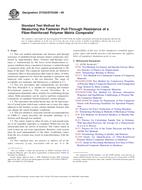Potřebujeme váš souhlas k využití jednotlivých dat, aby se vám mimo jiné mohly ukazovat informace týkající se vašich zájmů. Souhlas udělíte kliknutím na tlačítko „OK“.
ASTM D7332/D7332M-09
Standard Test Method for Measuring the Fastener Pull-Through Resistance of a Fiber-Reinforced Polymer Matrix Composite
Automaticky přeložený název:
Standardní zkušební metoda pro měření spojovacího prvku Odolnost proti protažení z vyztuženého vlákny Polymer Matrix Composite
NORMA vydána dne 1.9.2009
Informace o normě:
Označení normy: ASTM D7332/D7332M-09
Poznámka: NEPLATNÁ
Datum vydání normy: 1.9.2009
Kód zboží: NS-38214
Počet stran: 12
Přibližná hmotnost: 36 g (0.08 liber)
Země: Americká technická norma
Kategorie: Technické normy ASTM
Anotace textu normy ASTM D7332/D7332M-09 :
Keywords:
bolted joints, composite materials, fastener, fastener pull-through, out-of-plane loading, Composite materials, Fastener pull-through resistance, Fiber reinforced polymers, Polymer matrix composite materials, ICS Number Code 83.120 (Reinforced plastics)
Doplňující informace
| Significance and Use | ||||||||||||||||||||||||||||||||
|
This test method is designed to produce fastener pull-through resistance data for structural design allowables, research and development. The procedures may be used to assess pull-through resistance for a variety of composite laminate thicknesses, fastener diameters, and fastener head styles. However, the flexibility of test parameters allowed by the variants makes meaningful comparison between datasets difficult if the datasets were not generated using identical test parameters. Early composite pull-through tests using fasteners common to metal structures led to premature joint failures, and resulted in the development of fasteners specific for composite applications. These fasteners have larger heads and tails to reduce through-thickness compression stresses on the composite laminate. General factors that influence the mechanical response of composite laminates and should therefore be reported include the following: material, methods of material preparation and lay-up, specimen stacking sequence, specimen preparation, specimen conditioning, environment of testing, specimen alignment, speed of testing, time at temperature, void content, and volume percent reinforcement. Specific factors that influence the pull-through resistance of composite laminates and should therefore be reported include the following: hole diameter, fastener diameter, fastener head diameter, loading bar spacing to fastener hole diameter ratio (Procedure A), clearance hole diameter to fastener hole diameter ratio (Procedure B), diameter to thickness ratio, fastener torque, fastener or pin material, fastener or pin clearance, countersink angle and depth of countersink, type of grommet (if used), and type of support fixture. Fastener pull-through resistance properties which may be determined from this test method include initial sub-critical failure force/displacement, failure force, maximum force, and rupture displacement. |
||||||||||||||||||||||||||||||||
| 1. Scope | ||||||||||||||||||||||||||||||||
|
1.1 This test method determines the fastener pull-through resistance of multidirectional polymer matrix composites reinforced by high-modulus fibers. Fastener pull-through resistance is characterized by the force-versus-displacement response exhibited when a mechanical fastener is pulled through a composite plate, with the force applied perpendicular to the plane of the plate. The composite material forms are limited to continuous-fiber or discontinuous-fiber (tape or fabric, or both) reinforced composites for which the laminate is symmetric and balanced with respect to the test direction. The range of acceptable test laminates and thicknesses is defined in 8.2. 1.2 Two test procedures and configurations are provided. The first, Procedure A, is suitable for screening and fastener development purposes. The second, Procedure B, is configuration-dependent and is suitable for establishing design values. Both procedures can be used to perform comparative evaluations of candidate fasteners/fastener system designs. 1.3 The specimens described herein may not be representative of actual joints which may contain one or more free edges adjacent to the fastener, or may contain multiple fasteners that can change the actual boundary conditions. 1.4 This test method is consistent with the recommendations of CMH-17, which describes the desirable attributes of a fastener pull-through test method. 1.5 The values stated in either SI units or inch-pound units are to be regarded separately as standard. Within the text the inch-pound units are shown in brackets. The values stated in each system are not exact equivalents; therefore, each system must be used independently of the other. Combining values from the two systems may result in nonconformance with the standard. 1.6 This standard does not purport to address all of the safety concerns, if any, associated with its use. It is the responsibility of the user of this standard to establish appropriate safety and health practices and determine the applicability of regulatory limitations prior to use. |
||||||||||||||||||||||||||||||||
| 2. Referenced Documents | ||||||||||||||||||||||||||||||||
|




 Cookies
Cookies
